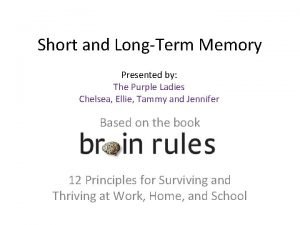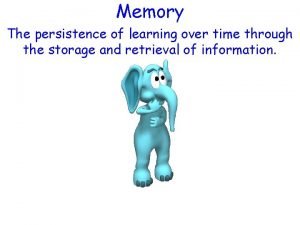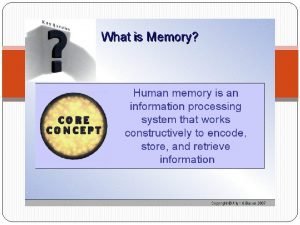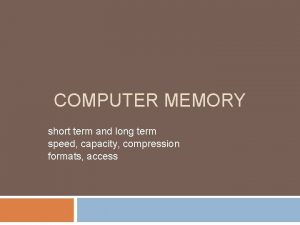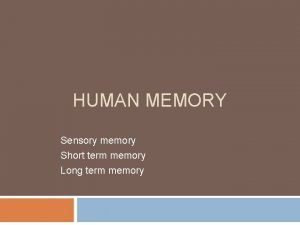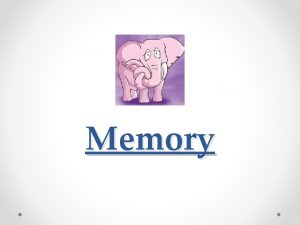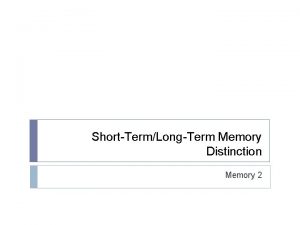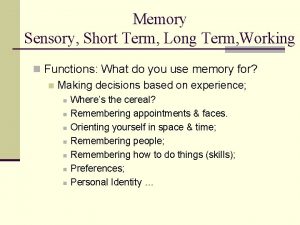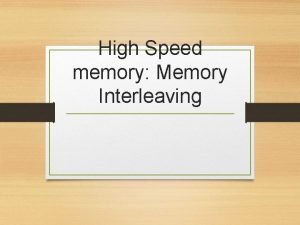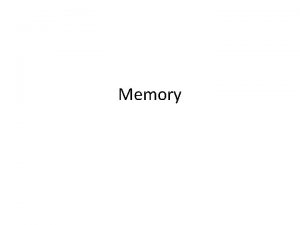COMPUTER MEMORY short term and long term speed













- Slides: 13

COMPUTER MEMORY short term and long term speed, capacity, compression formats, access

Short-term Memory - RAM Random access memory (RAM) on silicon chips 100 nano-second access time usually volatile (lose information if power turned off) data transferred at around 100 Mbytes/sec Some non-volatile RAM used to store basic set-up information Typical desktop computers: 64 to 256 Mbytes RAM

Long-term Memory - disks magnetic disks floppy disks store around 1. 4 Mbytes hard disks typically 40 Gbytes to 100 s of Gbytes access time ~10 ms, transfer rate 100 kbytes/s optical disks use lasers to read and sometimes write more robust that magnetic media CD-ROM - same technology as home audio, ~ 600 Gbytes DVD - for AV applications, or very large files

Speed and capacity what do the numbers mean? some sizes (all uncompressed) … this book, text only ~ 320, 000 words, 2 Mb the Bible ~ 4. 5 Mbytes scanned page ~ 128 Mbytes digital photo ~ 10 Mbytes (11 x 8 inches, 1200 dpi, 8 bit greyscale) (2– 4 mega pixels, 24 bit colour) video ~ 10 Mbytes per second (512 x 512, 12 bit colour, 25 frames per sec)

Compression reduce amount of storage required lossless recover exact text or image – e. g. GIF, ZIP look for commonalities: text: AAAAABBBBBCCCC 10 A 5 B 8 C video: compare successive frames and store change lossy recover something like original – e. g. JPEG, MP 3 exploit perception JPEG: lose rapid changes and some colour MP 3: reduce accuracy of drowned out notes

Storage formats - text ASCII - 7 -bit binary code for to each letter and character UTF-8 - 8 -bit encoding of 16 bit character set RTF (rich text format) - text plus formatting and layout information SGML (standardized generalised markup language) - documents regarded as structured objects XML (extended markup language) - simpler version of SGML for web applications

Storage formats - media Images: many storage formats : (Post. Script, GIFF, JPEG, TIFF, PICT, etc. ) plus different compression techniques (to reduce their storage requirements) Audio/Video again lots of formats : (Quick. Time, MPEG, WAV, etc. ) compression even more important also ‘streaming’ formats for network delivery

PROCESSING AND NETWORKS Moore’s law limits of interaction networked computing

Moore’s law computers get faster and faster! 1965 … similar pattern for memory Gordon Moore, co-founder of Intel, noticed a pattern processor speed doubles every 18 months PC … 1987: 1. 5 Mhz, 2002: 1. 5 GHz but doubles every 12 months!! hard disk … 1991: 20 Mbyte : 2002: 30 Gbyte baby born today record all sound and vision by 70 all life’s memories stored in a grain of dust!

The myth of the infinitely fast machine implicit assumption … no delays an infinitely fast machine what is good design for real machines? good example … the telephone : type keys too fast hear tones as numbers sent down the line actually an accident of implementation emulate in design

In design Focus: physical controls what is good design for real machines? specialist controls needed … industrial controls, consumer products, etc. easy-clean smooth buttons multi-function control large buttons clear dials tiny buttons

Networked computing Networks allow access to … large memory and processing other people (groupware, email) shared resources – esp. the web Issues network delays – slow feedback conflicts - many people update data unpredictability

The internet history … 1969: DARPANET US Do. D, 4 sites 1971: 23; 1984: 1000; 1989: 10000 common language (protocols): TCP – Transmission Control protocol IP – Internet Protocol lower level, packets (like letters) between machines reliable channel (like phone call) between programs on machines email, HTTP, all build on top of these
 Short short short long long long short short short
Short short short long long long short short short Long term memory vs short term memory
Long term memory vs short term memory Short medium and long term planning in education
Short medium and long term planning in education Short term human resources examples
Short term human resources examples Difference between long term and short term liabilities
Difference between long term and short term liabilities Accounting for serial bonds
Accounting for serial bonds Example of long term plans
Example of long term plans Research paper on financial planning and forecasting
Research paper on financial planning and forecasting Computer memory for short term storage
Computer memory for short term storage Once upon a time,there
Once upon a time,there Long term memory example
Long term memory example Prospective memory examples
Prospective memory examples Process of memory encoding
Process of memory encoding Capacity of long term memory
Capacity of long term memory










